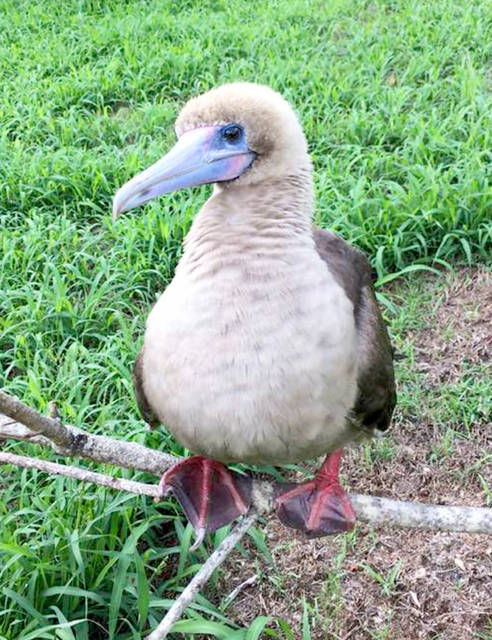KOLOA — Erick Lux spotted an unusual visitor to McBryde Garden one morning in mid-October. Perched in a Ceasalpinia bush was a red-footed booby with a broken wing. That bird is now healing on Hawaii Island. “NTBG (National Tropical Botanical
KOLOA — Erick Lux spotted an unusual visitor to McBryde Garden one morning in mid-October.
Perched in a Ceasalpinia bush was a red-footed booby with a broken wing. That bird is now healing on Hawaii Island.
“NTBG (National Tropical Botanical Garden) sees a lot of birds visiting the garden, but boobies are definitely a first for our staff,” said Jessica Clabo of NTBG.
Lux was checking on some recently planted baobab trees on Kauai’s South Shore when he saw the booby. Staff members watched it for a couple of hours to monitor its condition, before determining it wasn’t able to fly.
“While perched, the booby was holding its wing slightly off, but otherwise seemed quite healthy and inquisitive,” Clabo said.
NTBG staff then called Save Our Shearwaters, a bird rescue and rehabilitation group funded through Kauai Island Utility Cooperative.
SOS experts talked NTBG staff through securing the booby and transporting it to the SOS facility at the Kauai Humane Society.
“The bird was very calm and easy to contain using a blanket wrap,” Clabo said.
Red-footed boobies are the most common of the booby species in Hawaii, with 7,500 breeding pairs at colonies in most of the Northwestern Hawaiian Islands, and about 5,000 red-footed booby breeding pairs divided between colonies on Kaula Rock, Lehua Islet, Kauai and Oahu, according to the Kauai Endangered Species Recovery Project.
Red-footed boobies are one of six species in the genus — including the photogenic blue-footed booby, found in the Pacific from Southern California to Peru, and on the Galapagos Islands.
All boobies have brightly colored legs, which contribute to their names.
According to the American Bird Conservancy, the name “booby” may come from the Spanish word “bobo,” which means stupid. That’s because the birds don’t show fear of humans, according to ABC.
They are seabirds that fish for their food and usually lay one or two eggs in ground nests.
“One of the biggest colonies is on the North Shore, near the Kilauea Lighthouse,” said Tracy Anderson, head of SOS.
While finding a booby was a first for staff members at NTBG, red-footed boobies commonly are brought to SOS, according to Anderson.
But this bird was unique even for SOS staff members.
“What was unusual about this bird was its coloring,” Anderson said. “It’s a dark morph, or a brown morph.”
Adult red-footed boobies and their subspecies come in five colors, or morphs — among them white and brown. The adult red-footed boobies on Kauai are almost exclusively white.
“They (NTBG) thought it was a juvenile and, at first, we did too. But it’s not,” Anderson said. “It’s a fully grown adult. It’s just a different color.”
Once the unique red-footed booby made its way to the SOS facility, staff members discovered he had a fractured coracoid, or shoulder bone. The break was wrapped and he was put on cage-rest.
Thursday, the booby was transferred to Hawaii Wildlife Center on Hawaii Island, which has bigger conditioning cages than those at SOS.
“We just don’t have enough space for him out here,” Anderson said. “We have the wetland bird cage, but it’s not big enough for him to be able to fly.”
The red-footed booby will be at the Hawaii Wildlife Center until its wing has healed enough for it to be released back into the wild.


